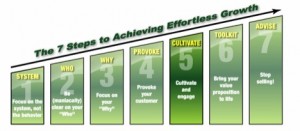 For 20 years I've had a tremendous sales advantage. As someone who enjoys writing and creating new ideas, I've leveraged my sales efforts with content, before content marketing even had a name. Today, one of the core things Imagine does is enable small and mid-sized companies to create the type of content to leverage those sales efforts.
For 20 years I've had a tremendous sales advantage. As someone who enjoys writing and creating new ideas, I've leveraged my sales efforts with content, before content marketing even had a name. Today, one of the core things Imagine does is enable small and mid-sized companies to create the type of content to leverage those sales efforts.
Last week I was presenting our new program Achieving Effortless Sales Growth to a group of CEOs in Canada. When I got to Step Five: Cultivate & Engage Your Market, a CEO asked about e-newsletters. He told me that a previous speaker had come and told them that no one reads newsletters anymore, so they’re just a waste of time.
My response: “People don’t read crappy newsletters and probably about 95% of the newsletters that go out are crappy. But, people absolutely read valuable newsletters.”
This advice is true of blogs, white papers, case studies and any other content you create to support your sales and marketing efforts. Two things are clear; with more and more content being created every day there is more noise than ever, so the stakes and thresholds are higher.
Your opportunity, if you meet that threshold, is that you’ll get heard while everyone else is ignored. Here are five rules to ensure your content breaks the noise barrier and resonates with your audience:
- Be maniacally clear on who you desire to communicate with.
- Focus on a clear and critical problem they are dealing with. The fastest way to get ignored is by focusing your content on your “unique” solutions.
- Develop and communicate a clear, Commercial Teaching Point-of-View.
- Always – ALWAYS – ensure that you are communicating something valuable. Remember, with content marketing you are in the publishing business. Ask, “Would my targeted audience be willing to pay to access this information.” If the answer is no, find something more valuable.
- Communicate consistently. We recommend consistency on a weekly to monthly basis. Rule four should determine your frequency – if the content you are sharing is valuable you’ll be good.

 Doug Davidoff
Doug Davidoff